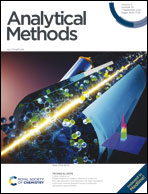One-step hydrothermal synthesis of nitrogen-doped carbon dots for high-sensitivity visual detection of nitrite and ascorbic acid†
Abstract
Ascorbic acid (AA) is an indispensable vitamin for the human body and is associated with critical processes of human metabolism. However, excessive intake of AA can also have a negative impact on human health. Nitrite is a commonly used food additive, and its overdose can increase the risk of cancer. Therefore, the detection of nitrite and vitamins is generally recognized to be meaningful. In this study, red-fluorescence and yellow-fluorescence CDs (r-CDs/y-CDs) were synthesized by a one-step hydrothermal method using o-phenylenediamine as the only carbon source. These two types of CDs exhibited good detection accuracy, detection limit and selectivity towards nitrite and AA (the detection limits are 0.47 μM and 45.1 μM, respectively). The long wavelength luminescent CDs prepared in this experiment also have high quantum yield (QY), which is of great significance to the visual detection effect. Under weak acidic conditions, the amino group on the surface of r-CDs can coordinate with nitrite and react to generate diazo groups, leading to the fluorescence quenching of CDs. The coordination between the y-CDs and the amino group on the surface of AA connects the adjacent y-CDs to form aggregates, which increases the non-radiative transition of electrons and induces the fluorescence quenching of CDs. This study proposes a new idea for the preparation of carbon dots for the determination of NO2− and AA in solutions, which expands the application of fluorescent CD detection.



 Please wait while we load your content...
Please wait while we load your content...